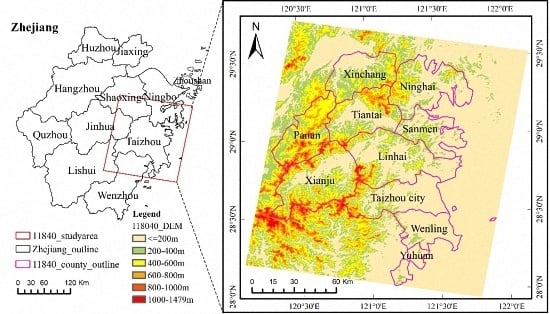Examining Forest Disturbance and Recovery in the Subtropical Forest Region of Zhejiang Province Using Landsat Time-Series Data
Abstract
:1. Introduction
2. Materials and Methods
2.1. Study Area
2.2. Data Preparation
2.3.Detection of Forest Disturbance and Recovery
2.4. Determination of Disturbance and Recovery Levels
3. Results
3.1. Analysis of LandTrendr Results
3.2. Spatial and Temporal Patterns of Forest Disturbance and Recovery
3.3. Analysis of Statistical Data of Forest Disturbance and Recovery
4. Discussion
5. Conclusions
- (1)
- LandTrendr algorithm can effectively detect forest disturbance and recovery classes, but dense Landsat time-series data are required for accurately extracting the disturbance and recovery features;
- (2)
- ground-truth data are critical to determine disturbance and recovery levels through identification of suitable thresholds, but are often unavailable; thus, high spatial resolution images with multiple temporal scales are very helpful;
- (3)
- forest disturbance and recovery detection is a comprehensive procedure that requires good design of different steps: collection of ground-truth data, selection of time-series remote sensing variables, algorithm, and evaluation of the results;
- (4)
- more research is needed to integrate multisource data for forest disturbance and recovery detection, especially in subtropical and tropical regions due to the frequent cloud-cover problem.
Acknowledgments
Author Contributions
Conflicts of Interest
References
- Chen, D.; Loboda, T.; Channan, S.; Hoffman-Hall, A. Long-term record of sampled disturbances in Northern Eurasian boreal forest from pre-2000 Landsat data. Remote Sens. 2014, 6, 6020–6038. [Google Scholar] [CrossRef]
- Chen, Y.; Luo, G.; Maisupova, B.; Chen, X.; Mukanov, B.M.; Wu, M.; Mambetov, B.T.; Huang, J.; Li, C. Carbon budget from forest land use and management in central Asia during 1961–2010. Agric. For. Meteorol. 2016, 221, 131–141. [Google Scholar] [CrossRef]
- Chen, G.; Tian, H.; Huang, C.; Prior, S.A.; Pan, S. Integrating a process-based ecosystem model with landsat imagery to assess impacts of forest disturbance on terrestrial carbon dynamics: Case studies in alabama and mississippi. J. Geophys. Res. Biogeosci. 2013, 118, 1208–1224. [Google Scholar] [CrossRef]
- Chen, G.; Tian, H.; Zhang, C.; Liu, M.; Ren, W. Drought in the southern United States over the 20th century: Variability and its impacts on terrestrial ecosystem productivity and carbon storage. Clim. Change 2012, 114, 379–397. [Google Scholar] [CrossRef]
- Wei, X.; Blanco, J.A. Significant increase in ecosystem c can be achieved with sustainable forest management in subtropical plantation forests. PLoS ONE 2014, 9, e89688. [Google Scholar] [CrossRef] [PubMed]
- Yu, G.; Chen, Z.; Piao, S.; Peng, C.; Ciais, P.; Wang, Q.; Zhu, X. High carbon dioxide uptake by subtropical forest ecosystems in the east Asian monsoon region. Proc. Natl. Acad. Sci. USA 2014, 111, 4910–4915. [Google Scholar] [CrossRef] [PubMed]
- Liu, S.; Zhou, T.; Wei, L.; Shu, Y. The spatial distribution of forest carbon sinks and sources in China. Chin. Sci. Bull. 2012, 57, 1699–1707. [Google Scholar] [CrossRef]
- Pickett, S.T.; White, P.S. The Ecology of Natural Disturbance and Patch Dynamics; Academic Press: Cambridge, MA, USA, 1985. [Google Scholar]
- Zhu, Z.; Woodcock, C.E.; Olofsson, P. Continuous monitoring of forest disturbance using all available Landsat imagery. Remote Sens. Environ. 2012, 122, 75–91. [Google Scholar] [CrossRef]
- Lu, D.; Li, G.; Moran, E. Current situation and needs of change detection techniques. Int. J. Image Data Fusion 2014, 5, 13–38. [Google Scholar] [CrossRef]
- Banskota, A.; Kayastha, N.; Falkowski, M.J.; Wulder, M.A.; Froese, R.E.; White, J.C. Forest monitoring using Landsat time series data: A review. Can. J. Remote Sens. 2014, 40, 362–384. [Google Scholar] [CrossRef]
- Bucha, T.; Stibig, H.J. Analysis of modis imagery for detection of clear cuts in the boreal forest in north-west Russia. Remote Sens. Environ. 2008, 112, 2416–2429. [Google Scholar] [CrossRef]
- Gitas, I.Z.; Mitri, G.H.; Ventura, G. Object-based image classification for burned area mapping of creus cape, Spain, using NOAA-AVHRR imagery. Remote Sens. Environ. 2004, 92, 409–413. [Google Scholar] [CrossRef]
- Jin, S.; Sader, S.A. MODIS time-series imagery for forest disturbance detection and quantification of patch size effects. Remote Sens. Environ. 2005, 99, 462–470. [Google Scholar] [CrossRef]
- Pouliot, D.; Latifovic, R.; Fernandes, R.; Olthof, I. Evaluation of annual forest disturbance monitoring using a static decision tree approach and 250 m MODIS data. Remote Sens. Environ. 2009, 113, 1749–1759. [Google Scholar] [CrossRef]
- DeVries, B.; Verbesselt, J.; Kooistra, L.; Herold, M. Robust monitoring of small-scale forest disturbances in a tropical montane forest using Landsat time series. Remote Sens. Environ. 2015, 161, 107–121. [Google Scholar] [CrossRef]
- Huang, C.; Goward, S.N.; Masek, J.G.; Thomas, N.; Zhu, Z.; Vogelmann, J.E. An automated approach for reconstructing recent forest disturbance history using dense Landsat time series stacks. Remote Sens. Environ. 2010, 114, 183–198. [Google Scholar] [CrossRef]
- Huang, C.; Goward, S.N.; Schleeweis, K.; Thomas, N.; Masek, J.G.; Zhu, Z. Dynamics of national forests assessed using the Landsat record: Case studies in eastern United States. Remote Sens. Environ. 2009, 113, 1430–1442. [Google Scholar] [CrossRef]
- Kennedy, R.E.; Cohen, W.B.; Schroeder, T.A. Trajectory-based change detection for automated characterization of forest disturbance dynamics. Remote Sens. Environ. 2007, 110, 370–386. [Google Scholar] [CrossRef]
- Vogelmann, J.E.; Gallant, A.L.; Shi, H.; Zhu, Z. Perspectives on monitoring gradual change across the continuity of Landsat sensors using time-series data. Remote Sens. Environ. 2016, 185, 258–270. [Google Scholar] [CrossRef]
- Hussain, M.; Chen, D.; Cheng, A.; Wei, H.; Stanley, D. Change detection from remotely sensed images: From pixel-based to object-based approaches. ISPRS J. Photogramm. Remote Sens. 2013, 80, 91–106. [Google Scholar] [CrossRef]
- Lu, D.; Mausel, P.; Brondizio, E.; Moran, E. Change detection techniques. Int. J. Remote Sens. 2004, 25, 2365–2401. [Google Scholar] [CrossRef]
- Meigs, G.W.; Kennedy, R.E.; Cohen, W.B. A Landsat time series approach to characterize bark beetle and defoliator impacts on tree mortality and surface fuels in conifer forests. Remote Sens. Environ. 2011, 115, 3707–3718. [Google Scholar] [CrossRef]
- Kennedy, R.E.; Yang, Z.; Braaten, J.; Copass, C.; Antonova, N.; Jordan, C.; Nelson, P. Attribution of disturbance change agent from Landsat time-series in support of habitat monitoring in the Puget Sound region, USA. Remote Sens. Environ. 2015, 166, 271–285. [Google Scholar] [CrossRef]
- Jarron, L.R.; Hermosilla, T.; Coops, N.C.; Wulder, M.A.; White, J.C.; Hobart, G.W.; Leckie, D.G. Differentiation of alternate harvesting practices using annual time series of Landsat data. Forests 2016. [Google Scholar] [CrossRef]
- Hermosilla, T.; Wulder, M.A.; White, J.C.; Coops, N.C.; Hobart, G.W. Regional detection, characterization, and attribution of annual forest change from 1984 to 2012 using Landsat-derived time-series metrics. Remote Sens. Environ. 2015, 170, 121–132. [Google Scholar] [CrossRef]
- Bontemps, S.; Langner, A.; Defourny, P. Monitoring forest changes in borneo on a yearly basis by an object-based change detection algorithm using SPOT-vegetation time series. Int. J. Remote Sens. 2012, 33, 4673–4699. [Google Scholar] [CrossRef]
- Chen, G.; Hay, G.J.; Carvalho, L.M.T.; Wulder, M.A. Object-based change detection. Int. J. Remote Sens. 2012, 33, 4434–4457. [Google Scholar] [CrossRef]
- Desclée, B.; Bogaert, P.; Defourny, P. Forest change detection by statistical object-based method. Remote Sens. Environ. 2006, 102, 1–11. [Google Scholar] [CrossRef]
- Lu, D.; Li, G.; Moran, E.; Dutra, L.; Batistella, M. The roles of textural images in improving land-cover classification in the brazilian amazon. Int. J. Remote Sens. 2014, 35, 8188–8207. [Google Scholar] [CrossRef]
- Xi, Z.; Lu, D.; Liu, L.; Ge, H. Detection of drought-induced hickory disturbances in western Lin An county, China, using multitemporal Landsat imagery. Remote Sens. 2016, 8, 345. [Google Scholar] [CrossRef]
- Kennedy, R.E.; Townsend, P.A.; Gross, J.E.; Cohen, W.B.; Bolstad, P.; Wang, Y.Q.; Adams, P. Remote sensing change detection tools for natural resource managers: Understanding concepts and tradeoffs in the design of landscape monitoring projects. Remote Sens. Environ. 2009, 113, 1382–1396. [Google Scholar] [CrossRef]
- Devries, B.; Decuyper, M.; Verbesselt, J.; Zeileis, A.; Herold, M.; Joseph, S. Tracking disturbance-regrowth dynamics in tropical forests using structural change detection and landsat time series. Remote Sens. Environ. 2015, 169, 320–334. [Google Scholar] [CrossRef]
- Vogelmann, J.E.; Tolk, B.; Zhu, Z. Monitoring forest changes in the southwestern United States using multitemporal landsat data. Remote Sens. Environ. 2009, 113, 1739–1748. [Google Scholar] [CrossRef]
- Vogelmann, J.E.; Xian, G.; Homer, C.; Tolk, B. Monitoring gradual ecosystem change using Landsat time series analyses: Case studies in selected forest and rangeland ecosystems. Remote Sens. Environ. 2012, 122, 92–105. [Google Scholar] [CrossRef]
- Lehmann, E.A.; Wallace, J.F.; Caccetta, P.A.; Furby, S.L.; Zdunic, K. Forest cover trends from time series Landsat data for the Australian continent. Int. J. Appl. Earth Obs. Geoinform. 2013, 21, 453–462. [Google Scholar] [CrossRef]
- Masek, J.G.; Huang, C.; Wolfe, R.; Cohen, W.; Hall, F.; Kutler, J.; Nelson, P. North American forest disturbance mapped from a decadal Landsat record. Remote Sens. Environ. 2008, 112, 2914–2926. [Google Scholar] [CrossRef]
- Guo, X.-y.; Zhang, H.-y.; Wang, Y.-q.; Clark, J. Mapping and assessing typhoon-induced forest disturbance in Changbai mountain national nature reserve using time series Landsat imagery. J. Mt. Sci. 2015, 12, 404–416. [Google Scholar] [CrossRef]
- Li, M.; Huang, C.; Shen, W.; Ren, X.; Lv, Y.; Wang, J.; Zhu, Z. Characterizing long-term forest disturbance history and its drivers in the Ning-Zhen mountains, Jiangsu province of eastern China using yearly Landsat observations (1987–2011). J. For. Res. 2016, 27, 1329–1341. [Google Scholar] [CrossRef]
- Masek, J.G.; Goward, S.N.; Kennedy, R.E.; Cohen, W.B.; Moisen, G.G.; Schleeweis, K.; Huang, C. United States forest disturbance trends observed using Landsat time series. Ecosystems 2013, 16, 1087–1104. [Google Scholar] [CrossRef]
- Kennedy, R.E.; Yang, Z.; Cohen, W.B. Detecting trends in forest disturbance and recovery using yearly Landsat time series: 1. Landtrendr—Temporal segmentation algorithms. Remote Sens. Environ. 2010, 114, 2897–2910. [Google Scholar] [CrossRef]
- Cohen, W.B.; Yang, Z.; Kennedy, R. Detecting trends in forest disturbance and recovery using yearly Landsat time series: 2. Timesync—Tools for calibration and validation. Remote Sens. Environ. 2010, 114, 2911–2924. [Google Scholar] [CrossRef]
- Cohen, W.B.; Yang, Z.; Stehman, S.V.; Schroeder, T.A.; Bell, D.M.; Masek, J.G.; Huang, C.; Meigs, G.W. Forest disturbance across the conterminous United States from 1985–2012: The emerging dominance of forest decline. For. Ecol. Manag. 2016, 360, 242–252. [Google Scholar] [CrossRef]
- Frazier, R.J.; Coops, N.C.; Wulder, M.A. Boreal shield forest disturbance and recovery trends using Landsat time series. Remote Sens. Environ. 2015, 170, 317–327. [Google Scholar] [CrossRef]
- Grogan, K.; Pflugmacher, D.; Hostert, P.; Kennedy, R.; Fensholt, R. Cross-border forest disturbance and the role of natural rubber in mainland southeast Asia using annual Landsat time series. Remote Sens. Environ. 2015, 169, 438–453. [Google Scholar] [CrossRef]
- Verbesselt, J.; Zeileis, A.; Herold, M. Near real-time disturbance detection using satellite image time series. Remote Sens. Environ. 2012, 123, 98–108. [Google Scholar] [CrossRef]
- Verbesselt, J.; Hyndman, R.; Newnham, G.; Culvenor, D. Detecting trend and seasonal changes in satellite image time series. Remote Sens. Environ. 2010, 114, 106–115. [Google Scholar] [CrossRef]
- Zhu, Z.; Woodcock, C.E. Continuous change detection and classification of land cover using all available Landsat data. Remote Sen. Environ. 2013, 144, 152–171. [Google Scholar] [CrossRef]
- Meddens, A.J.H.; Hicke, J.A.; Vierling, L.A.; Hudak, A.T. Evaluating methods to detect bark beetle-caused tree mortality using single-date and multi-date Landsat imagery. Remote Sens. Environ. 2013, 132, 49–58. [Google Scholar] [CrossRef]
- Schwantes, A.M.; Swenson, J.J.; Jackson, R.B. Quantifying drought-induced tree mortality in the open canopy woodlands of central Texas. Remote Sens. Environ. 2016, 181, 54–64. [Google Scholar] [CrossRef]
- Lambert, J.; Drenou, C.; Denux, J.P.; Balent, G.; Cheret, V. Monitoring forest decline through remote sensing time series analysis. GISci. Remote Sens. 2013, 50, 437–457. [Google Scholar]
- Chen, Y.; Lu, D.; Luo, G.; Huang, J. Detection of vegetation abundance change in the alpine tree line using multitemporal Landsat Thematic Mapper imagery. Int. J. Remote Sens. 2015, 36, 4683–4701. [Google Scholar] [CrossRef]
- Griffiths, P.; Kuemmerle, T.; Baumann, M.; Radeloff, V.C.; Abrudan, I.V.; Lieskovsky, J.; Munteanu, C.; Ostapowicz, K.; Hostert, P. Forest disturbances, forest recovery, and changes in forest types across the Carpathian ecoregion from 1985 to 2010 based on Landsat image composites. Remote Sens. Environ. 2014, 151, 72–88. [Google Scholar] [CrossRef]
- Pouliot, D.; Latifovic, R. Land change attribution based on Landsat time series and integration of ancillary disturbance data in the Athabasca oil sands region of Canada. GISci. Remote Sens. 2016, 53, 382–401. [Google Scholar] [CrossRef]
- Li, L.; Lu, D.; Kuang, W. Examining urban impervious surface distribution and its dynamic change in Hangzhou metropolis. Remote Sens. 2016, 8, 265. [Google Scholar] [CrossRef]
- The “Deforestation for Cultivation” Project Seriously Damaged Forest Resources in Zhejiang Province (In Chinese). Available online: https://www.greenpeace.org.cn/deforestation-in-zhejiang-province (accessed on 20 April 2017).
- Masek, J.G.; Vermote, E.F.; Saleous, N.E.; Wolfe, R.; Hall, F.G.; Huemmrich, K.F.; Gao, F.; Kutler, J.; Lim, T.-K. A Landsat surface reflectance dataset for North America, 1990–2000. IEEE Geosci. Remote Sens. Lett. 2006, 3, 68–72. [Google Scholar] [CrossRef]
- Vermote, E.; Tanre, D.; Deuze, J.L.; Herman, M.; Morcrette, J.J. Second simulation of the satellite signal in the solar spectrum, 6S: An overview. IEEE Trans. Geosci. Remote Sens. 1997, 35, 675–686. [Google Scholar] [CrossRef]
- Baig, M.H.A.; Zhang, L.; Shuai, T.; Tong, Q. Derivation of a Tasselled cap transformation based on Landsat 8 at-satellite reflectance. Remote Sens. Lett. 2014, 5, 423–431. [Google Scholar] [CrossRef]
- Crist, E.P. A TM Tasseled cap equivalent transformation for reflectance factor data. Remote Sens. Environ. 1985, 17, 301–306. [Google Scholar] [CrossRef]
- Zhu, Z.; Wang, S.; Woodcock, C.E. Improvement and expansion of the Fmask algorithm: Cloud, cloud shadow, and snow detection for Landsats 4–7, 8, and Sentinel 2 images. Remote Sens. Environ. 2015, 159, 269–277. [Google Scholar] [CrossRef]
- Zhu, Z.; Woodcock, C.E. Object-based cloud and cloud shadow detection in Landsat imagery. Remote Sens. Environ. 2012, 118, 83–94. [Google Scholar] [CrossRef]
- Lu, D.; Hetrick, S.; Moran, E.; Li, G. Detection of urban expansion in an urban-rural landscape with multitemporal Quickbird images. J. Appl. Remote Sens. 2010, 4, 201–210. [Google Scholar] [CrossRef] [PubMed]
- Senf, C.; Pflugmacher, D.; Wulder, M.A.; Hostert, P. Characterizing spectral–temporal patterns of defoliator and bark beetle disturbances using Landsat time series. Remote Sens. Environ. 2015, 170, 166–177. [Google Scholar] [CrossRef]
- Bannari, A.; Morin, D.; Bonn, F.; Huete, A.R. A review of vegetation indices. Remote Sens. Rev. 1995, 13, 95–120. [Google Scholar] [CrossRef]
- Zhao, P.; Lu, D.; Wang, G.; Wu, C.; Huang, Y.; Yu, S. Examining spectral reflectance saturation in Landsat imagery and corresponding solutions to improve forest aboveground biomass estimation. Remote Sens. 2016, 8, 469. [Google Scholar] [CrossRef]
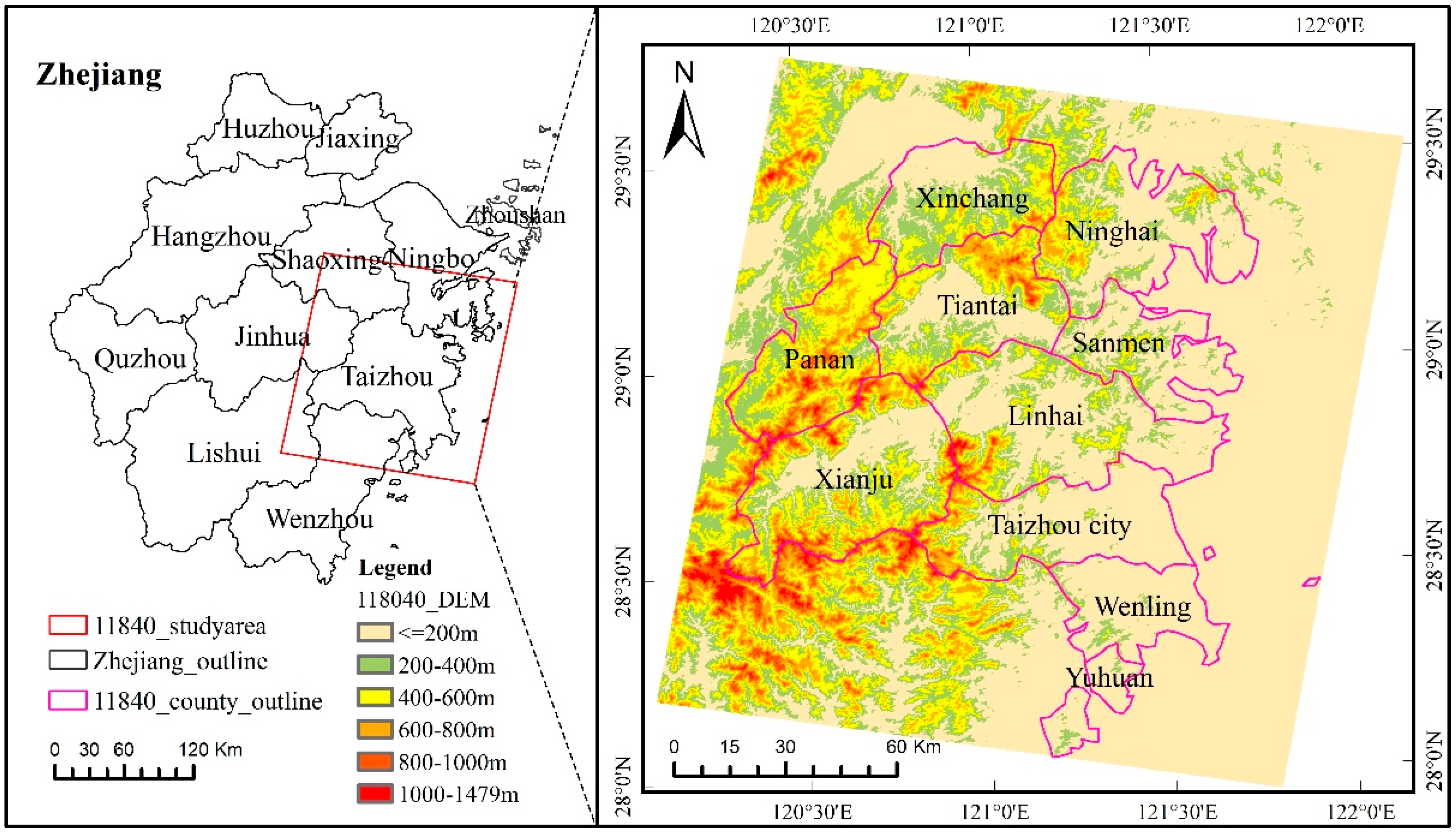
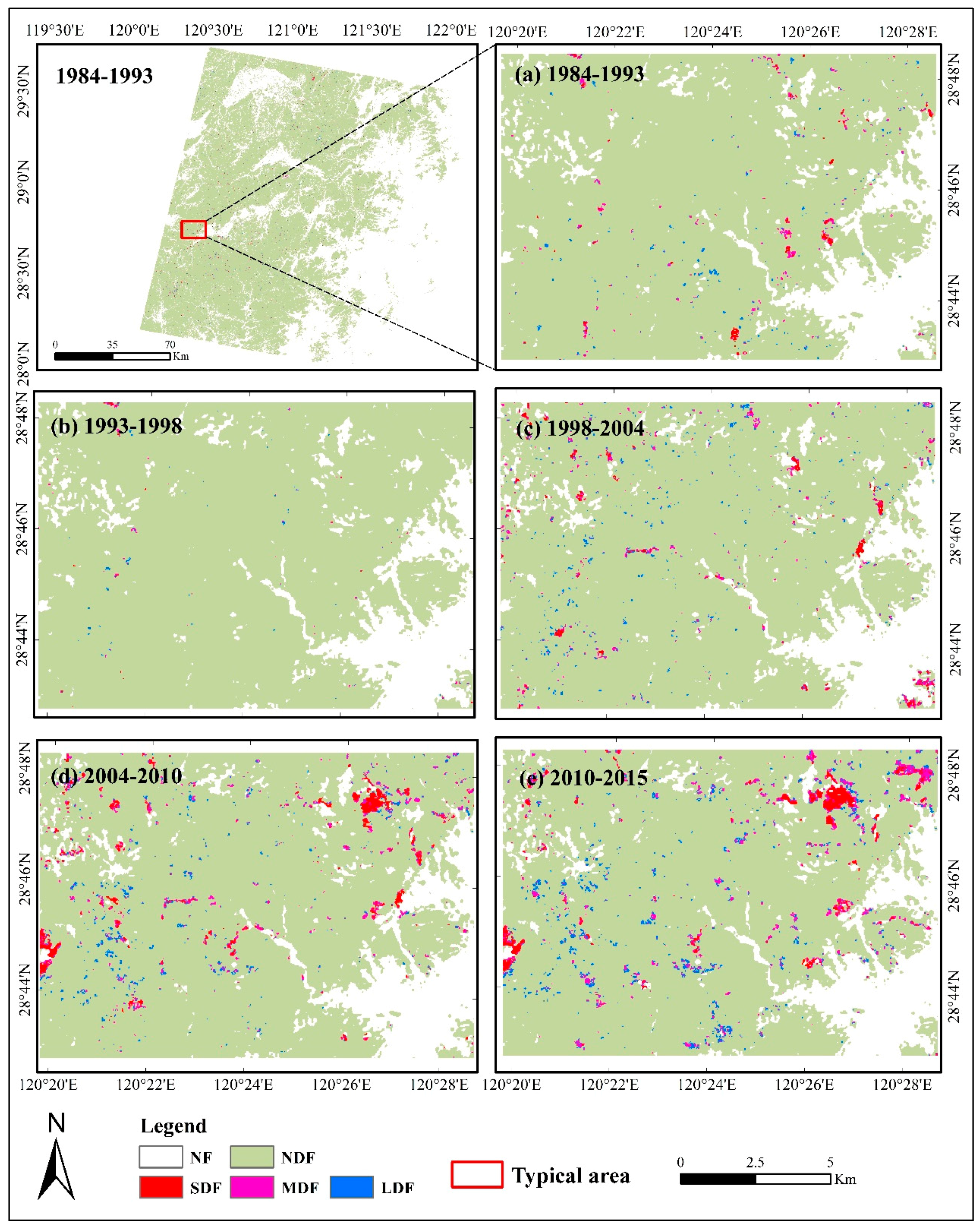
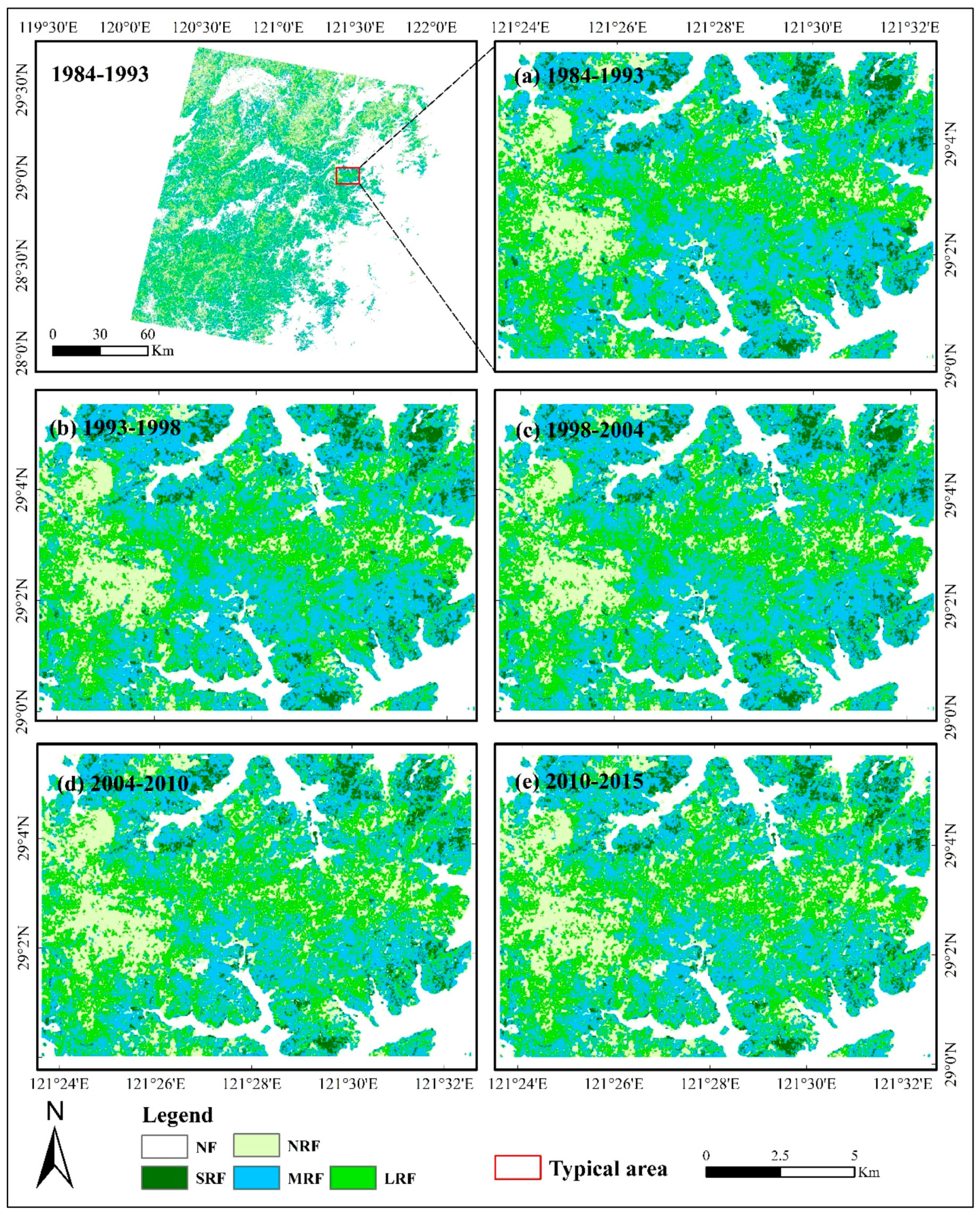
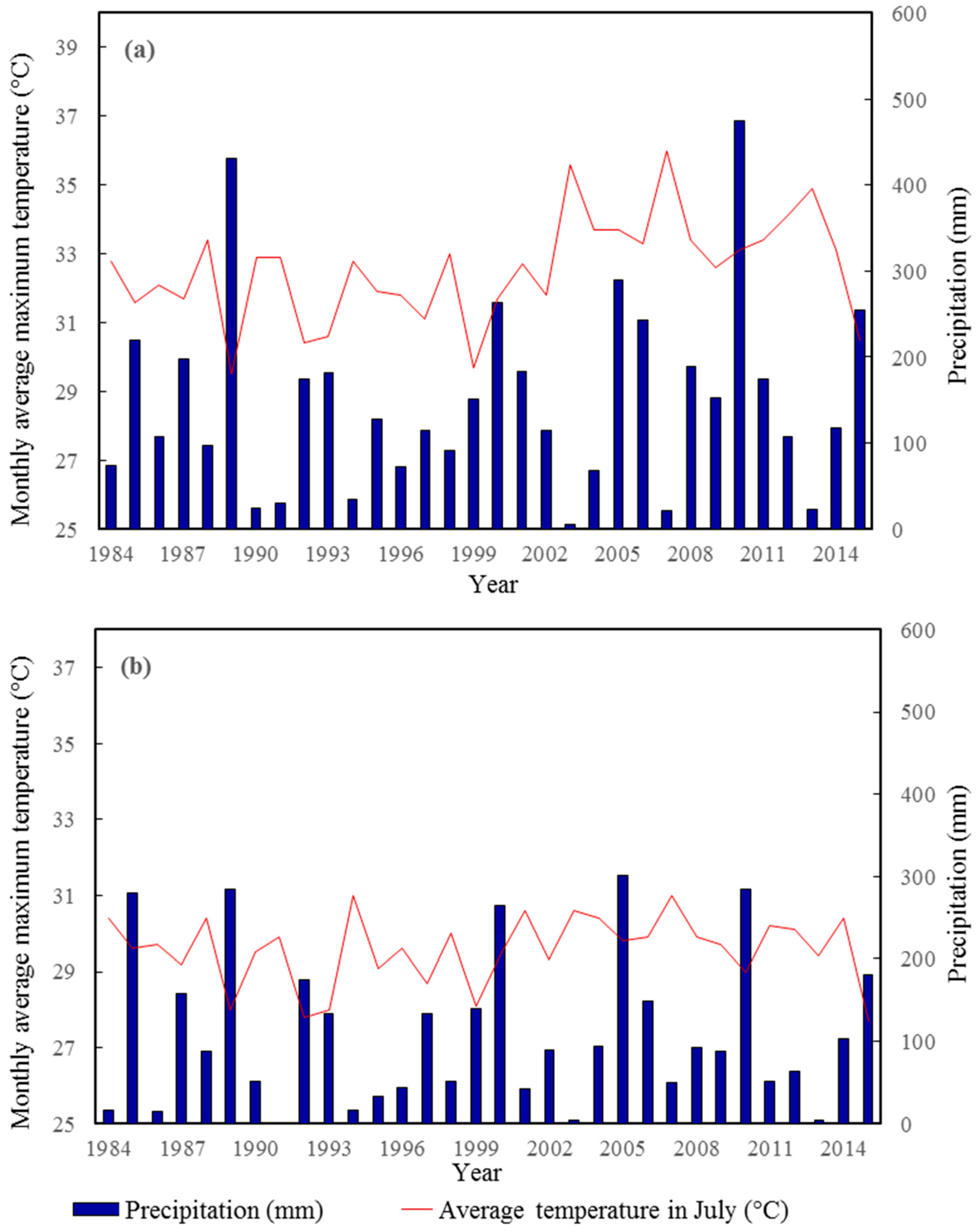
| Data | Description | Data Sources |
|---|---|---|
| Landsat (path/row: 118/040) | Landsat 5 Thematic Mapper (TM) images: 1984-05-09, 1987-05-18, 1988-07-07, 1990-06-11, 1992-08-03, 1993-06-03, 1998-08-20, 2002-10-02, 2003-08-02, 2004-08-04, 2007-07-28 Landsat 7 Enhanced Thematic Mapper Plus (ETM+): 2000-06-14, 2010-05-25 Landsat 8 Operational Land Imager (OLI): 2013-08-29, 2015-08-13 | Most of these Landsat images were downloaded from United States Geological Survey (USGS) (http://landsat.usgs.gov/), and some were from Chinese Academy of Sciences geographic information space data cloud (http://www.gscloud.cn/). The OLI image on 2013-08-29 was obtained from the combination of images between August 1 and September 30 because of the cloud problem. |
| DEM | ASTER (Advanced Spaceborne Thermal Emission and Reflection Radiometer) GDEM (Global Digital Elevation Model) data with 30 m spatial resolution were used for modification of croplands. | http://gdem.ersdac.jspacsystems.or.jp/ |
| Climate data | Temperature and precipitation data were collected from meteorological stations for the study area for 1984–2013. | China Meteorological Administration |
| Field survey | Forest inventory data within the study area were collected for 1994, 1999, and 2004. For each sample plot, vegetation type, dominant tree species, age, and others were measured. | China Forestry Administration |
| High resolution images | High resolution images were used for validation of forest disturbance results for 2004–2015 | Google Earth |
| Levels | Definition | Thresholds | |
|---|---|---|---|
| Disturbance | Serious | Forests are completely removed through clear-cutting or burning; for example, the conversion from forest to agriculture lands and buildings. | |
| Moderate | Forests are seriously disturbed due to different reasons such as selective logging, drought, or disease. | ||
| Light | Forest disturbance can be observed in the field or image due to change of forest stand structures. | ||
| Recovery | Strong | The conversion from non-forest types to plantations, mainly through afforestation. | |
| Moderate | Change of forest structure such as from sparse forest to dense forest is obviously detected. | ||
| Light | Change of forest structure such as density can be observed in the field or image due to growth. | ||
| Disturbance | Recovery | Stable | Producer Accuracy | User Accuracy | Overall Accuracy | ||
|---|---|---|---|---|---|---|---|
| Forest Inventory Data | Disturbance | 34 | 15 | 6 | 61.82 | 80.95 | 75.86 |
| Recovery | 8 | 136 | 33 | 76.84 | 89.47 | ||
| Stable | 0 | 1 | 28 | 96.55 | 41.79 | ||
| Timesync | Disturbance | 55 | 1 | 0 | 98.21 | 93.22 | 81.37 |
| Recovery | 3 | 164 | 45 | 77.36 | 95.35 | ||
| Stable | 1 | 7 | 30 | 78.95 | 40.00 |
| Changed Areas within Detection Periods (km2) | ||||||
| 1984–1993 | 1993–1998 | 1998–2004 | 2004–2010 | 2010–2015 | ||
| Disturbance levels | Serious | 19.76 | 6.57 | 60.55 | 72.87 | 95.19 |
| Medium | 51.14 | 17.70 | 151.54 | 121.06 | 205.79 | |
| Light | 63.37 | 22.67 | 141.80 | 86.09 | 193.37 | |
| Recovery levels | Strong | 518.38 | 507.46 | 540.14 | 449.50 | 431.34 |
| Medium | 4662.89 | 4461.47 | 4722.12 | 4075.60 | 3941.90 | |
| Light | 5080.17 | 5064.10 | 5164.31 | 5142.76 | 5058.48 | |
| Annual Average Change Rate (km2/year) during Each Period | ||||||
| Disturbance levels | Serious | 2.20 | 1.31 | 10.09 | 12.15 | 19.04 |
| Medium | 5.68 | 3.54 | 25.26 | 20.18 | 41.16 | |
| Light | 7.04 | 4.53 | 23.63 | 14.35 | 38.67 | |
| Recovery levels | Strong | 57.60 | 101.49 | 90.02 | 74.92 | 86.27 |
| Medium | 518.10 | 892.29 | 787.02 | 679.27 | 788.38 | |
| Light | 564.46 | 1012.82 | 860.72 | 857.13 | 1011.70 | |
| Detection Periods | Change Area within the Detection Periods (km2) | Average Annual Change Rate (km2/year) | ||||||||||
|---|---|---|---|---|---|---|---|---|---|---|---|---|
| Disturbance Levels | Recovery Levels | Disturbance Levels | Recovery Levels | |||||||||
| SDF | MDF | LDF | SRF | MRF | LRF | SDF | MDF | LDF | SRF | MRF | LRF | |
| 1984–1987 | 0.79 | 8.56 | 31.78 | 448.77 | 4227.31 | 4819.51 | 0.26 | 2.85 | 10.59 | 149.59 | 1409.10 | 1606.50 |
| 1987–1988 | 1.99 | 14.62 | 35.62 | 472.52 | 4341.22 | 4941.26 | 1.99 | 14.62 | 35.62 | 472.52 | 4341.22 | 4941.26 |
| 1988–1990 | 5.03 | 19.18 | 29.28 | 483.24 | 4423.47 | 4977.57 | 2.52 | 9.59 | 14.64 | 241.62 | 2211.74 | 2488.79 |
| 1990–1992 | 16.27 | 35.90 | 37.12 | 493.81 | 4461.31 | 4990.48 | 8.14 | 17.95 | 18.56 | 246.91 | 2230.66 | 2495.24 |
| 1992–1993 | 16.16 | 35.38 | 35.32 | 514.76 | 4565.77 | 5017.53 | 16.16 | 35.38 | 35.32 | 514.76 | 4565.77 | 5017.53 |
| 1993–1998 | 6.57 | 17.70 | 22.67 | 506.99 | 4450.71 | 5075.32 | 1.31 | 3.54 | 4.53 | 101.40 | 890.14 | 1015.06 |
| 1998–2000 | 13.67 | 48.66 | 53.88 | 500.51 | 4416.54 | 5056.94 | 6.84 | 24.33 | 26.94 | 250.26 | 2208.27 | 2528.47 |
| 2000–2002 | 24.34 | 84.03 | 91.76 | 429.04 | 3979.19 | 4920.59 | 12.17 | 42.02 | 45.88 | 214.52 | 1989.60 | 2460.30 |
| 2002–2003 | 29.39 | 85.30 | 90.62 | 425.11 | 3914.45 | 4809.91 | 29.39 | 85.30 | 90.62 | 425.11 | 3914.45 | 4809.91 |
| 2003–2004 | 38.79 | 78.16 | 67.26 | 430.74 | 3953.67 | 4919.10 | 38.79 | 78.16 | 67.26 | 430.74 | 3953.67 | 4919.10 |
| 2004–2007 | 48.05 | 82.72 | 67.01 | 437.93 | 3977.30 | 4982.83 | 16.02 | 27.57 | 22.34 | 145.98 | 1325.77 | 1660.94 |
| 2007–2010 | 53.80 | 94.51 | 71.91 | 442.46 | 3987.21 | 5138.02 | 17.93 | 31.50 | 23.97 | 147.49 | 1329.07 | 1712.67 |
| 2010–2013 | 95.02 | 196.23 | 181.32 | 431.16 | 3930.57 | 5069.98 | 31.67 | 65.41 | 60.44 | 143.72 | 1310.19 | 1689.99 |
| 2013–2015 | 78.95 | 186.03 | 189.06 | 416.97 | 3591.27 | 4446.15 | 39.48 | 93.02 | 94.53 | 208.49 | 1795.64 | 2223.08 |
© 2017 by the authors. Licensee MDPI, Basel, Switzerland. This article is an open access article distributed under the terms and conditions of the Creative Commons Attribution (CC BY) license (http://creativecommons.org/licenses/by/4.0/).
Share and Cite
Liu, S.; Wei, X.; Li, D.; Lu, D. Examining Forest Disturbance and Recovery in the Subtropical Forest Region of Zhejiang Province Using Landsat Time-Series Data. Remote Sens. 2017, 9, 479. https://doi.org/10.3390/rs9050479
Liu S, Wei X, Li D, Lu D. Examining Forest Disturbance and Recovery in the Subtropical Forest Region of Zhejiang Province Using Landsat Time-Series Data. Remote Sensing. 2017; 9(5):479. https://doi.org/10.3390/rs9050479
Chicago/Turabian StyleLiu, Shanshan, Xinliang Wei, Dengqiu Li, and Dengsheng Lu. 2017. "Examining Forest Disturbance and Recovery in the Subtropical Forest Region of Zhejiang Province Using Landsat Time-Series Data" Remote Sensing 9, no. 5: 479. https://doi.org/10.3390/rs9050479




